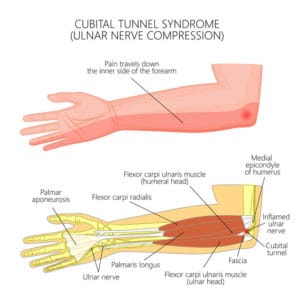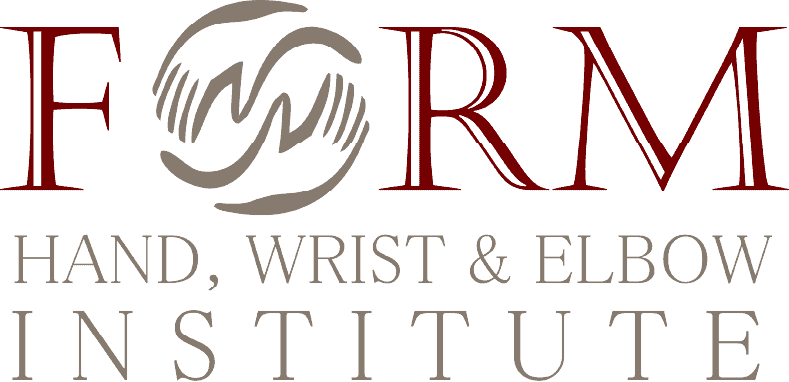Cubital Tunnel Syndrome
Cubital tunnel syndrome or ulnar neuropathy is typically caused by increased pressure on the ulnar nerve. The ulnar nerve is located very close to the skin’s surface in the region of the elbow, commonly known as the “funny bone.”
Cubital tunnel syndrome can be the cause of considerable pain and disability for patients. In most cases, the condition can be managed with conservative treatments. But more severe cases may require surgery to reduce pressure on the affected nerve.
Elbow Anatomy

The elbow bones and the muscles in the forearm running across the elbow join together to form the cubital tunnel. The ulnar nerve, which travels from the neck to the hand, passes through this tunnel and is responsible for sending sensation to your fingers as well as helping the muscles to move your hand. Cubital tunnel syndrome occurs when the ulnar nerve becomes restricted due to increased pressure at the elbow within the cubital tunnel. This generally happens because the tissue is swollen due to overuse or repetitive use of the elbow
Symptoms and Causes of Cubital Tunnel Syndrome
Symptoms for cubital tunnel syndrome include:
- Elbow pain
- Stiffness in the elbow
- Loss of strength in the hand
- Pain and /or tingling in the fingers
- Numbness in the fingers
- Inability to pinch thumb and little finger
- Claw-like deformity of the hand
If the symptoms of cubital tunnel syndrome are left untreated for a long time, the nerve damage can become permanent.

Causes of Cubital Tunnel Syndrome
The causes of cubital tunnel syndrome are unknown, but the symptoms tend to worsen if the elbow is bent for long periods. Resting your elbow on hard surfaces repeatedly and bending the elbow while working on a computer, talking on the phone, playing a musical instrument, or sleeping with your hand under the pillow can all contribute to worsening symptoms of cubital tunnel syndrome.
Swelling of the tendon lining, joint dislocation, fractures, and arthritis contributes to the onset of cubital tunnel syndrome. Fluid retention during pregnancy can also cause swelling in the cubital tunnel. Additionally, the twisting action used by baseball pitchers while throwing the ball can damage elbow ligaments and increase the risk for cubital tunnel syndrome.
Diagnosing Cubital Tunnel Syndrome
In some cases, a physical examination by your doctor is sufficient to confirm cubital tunnel syndrome. In other cases, x-rays and nerve conduction tests might be ordered to confirm the diagnosis and check the extent of the damage. During a nerve conduction test, the nerve is stimulated in one place, and the time it takes for there to be a response is measured. Several places along the nerve are usually tested, and the area where the response takes too long is diagnosed as the most likely region where the nerve is compressed. The test can also highlight any muscle damage caused by nerve compression.
Treatment for Cubital Tunnel Syndrome
There are many treatment options available for cubital tunnel syndrome that include both nonsurgical and surgical approaches.
Nonsurgical Treatments
As long as you are not experiencing symptoms of muscle wasting, your doctor will recommend conservative treatment options to treat cubital tunnel syndrome. Conservative treatment options include:
- Non-steroidal anti-inflammatory drugs to reduce soft tissue swelling
- Cortisone injections to relieve inflammation
- Elbow splints to minimize nerve irritation
- Stretching and strengthening exercises
Surgical Treatments
If nonsurgical methods do not improve your symptoms or if the nerve compression is causing muscle weakness or damage in your hand, your doctor may recommend surgery. Surgery is performed to relieve pressure on the ulnar nerve at the elbow. Dr. Besh will discuss surgical options with you during your consultation.
Recovery from Cubital Tunnel Syndrome Surgery
Whatever surgery you have, you will need to wear a splint for a few weeks after the operation. Physical therapy exercises may also be recommended to help you regain strength and motion in your arm.
